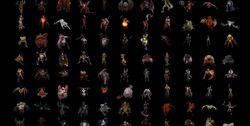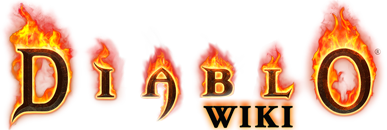(src)
Monsters are the creatures that do not reside in towns, and basically any non-player enemy in game is a monster. They are found inside the Tristram Cathedral in Diablo I and are found almost everywhere except towns in subsequent games.
Overview
Monsters will attack the player on sight, as soon as they notice them (each monster has a line of sight and detection radius). With some very rare exceptions, monsters offer no interaction other than combat.
As the combat progresses, the monster's health bar goes down. If the last slice of health disappears, the player will see will see one or more of the following happen:
- The monster dies and you will see its death animation. The corpse is left behind: it can be walked on freely, but will block doors.
- Experience is rewarded to you. The tougher the monster was, the more experience you will get. If you earn more experience than there is room on the Experience bar and you are level 98 or lower, your character gains an extra character level.
- There is a chance that the monster drops items on the ground. The tougher the monster was, the better the items you might get. It is not guaranteed that there will be drops. There is also a fair chance that nothing is dropped. The loot dropped has nothing to do with the weaponry an enemy is carrying: i.e. killing a Skeletal Archer does not grant any extra chance to drop a Bow compared to a regular Skeleton. There are some exceptions to it, though: some monsters, usually quest monsters (see next) may drop a guaranteed item.
- Some tough enemies are quest monsters. Defeating them for the first time completes a quest. Killing an Act Boss grants you access to the next Act. Killing the final boss grants access to the next difficulty (in Diablo II) or Adventure Mode (in Diablo III).
Most monsters are classified as one of three major types: Animal, Undead and Demon. If the monster-type is not displayed, the monster is usually an animal. Some attacks and skills are stronger if they are directed against a specific type.
- Animals (a.k.a. Beasts) are mostly creatures native to Sanctuary, usually non-sapient and savage.
- Demons are hellspawned creatures, often sapient and native to Burning Hells. Most Bosses are of this type.
- Undead are beings risen from the grave, regardless of their origin. In all three games, they are vulnerable to blunt weaponry and holy magic.
Diablo I
See also: Diablo I Bestiary (Hellfire Bestiary)
In Diablo I, the monster's name appear on the lower left in the status bar, written in white. If the monster is a unique monster, its name and information are written in gold. Monster type is not displayed, however, but is usually easy to guess.
Animals are more vulnerable to sharp weapons in this game, and less vulnerable to blunt weapons, while undead enemies are more vulnerable to blunt and less to sharp. Demons are equally vulnerable to both.
If the player has already encountered and killed a certain number of monsters of the same kind, more information such asresistances and immunities will be revealed in the status window.
Diablo II
See also: Diablo II Bestiary (Lord of Destruction Bestiary)
Monsters return in Diablo II, found in each act outside towns. In this game, monsters have 14 possible classifications of animation, from basics such as Walk, Attack 1, and Death, to the seldom-used Block, Run, and four Special modes, reserved for miscellaneous animations. Diablo is the only monster who uses every animation category available.[1]
In the middle top of the screen, one will see the monster's name and its health bar. The color of the monster name has the following meaning:
- White: It is a normal monster.
- Blue: It is a Berserker, Champion, Fanatic, Ghostly or Possessed monster.
- Golden: It is a Unique, Super Unique monster or an Act Boss.
In addition to the three major types, one can also encounter construct monsters, who are usually immobile, immune to poison and are more traps than monsters.
While animals and demons are now equally responsive to all weapons, unless specifically stated otherwise, undead enemies always take 50% extra damage from blunt weapons.
Diablo III

The Diablo III monster roster
See also: Diablo III Bestiary
Monsters appear in Diablo III, much the same as in Diablo II. However, they may attack towns in Campaign Mode as per key events in the storyline.
In the middle top of the screen, the player will see the monster's name and its health bar. The color of the monster name has the following meaning:
- White: It is a normal monster.
- Blue: It is a Champion.
- Yellow: It is a Rare.
- Purple: It is a Unique or an Act Boss.
In addition to the three major types, one may also encounter human enemies, as well as Reapers and some minor types, often unique to a specific quest-related enemy. It is the first game in which players may fight angels, some of them corrupted, and some insane.
Trivia
- While developers and fans often use the word "monsters" to address to enemies in Diablo games, only a few game characters call them so, including Covetous Shen (when he is rescued from the barrel) and Larzuk (regarding Shenk). Other characters prefer calling them demons, creatures, fiends etc.
- Each monster has about twenty different animations in Diablo III.[2]
References
- ↑ 2000-10-25, Postmortem: Blizzard's Diablo II. Gamastura, accessed on 2015-07-05
- ↑ 2016-12-19, Animation Support ft. Non Thareechit. YouTube, accessed on 2016-12-21
